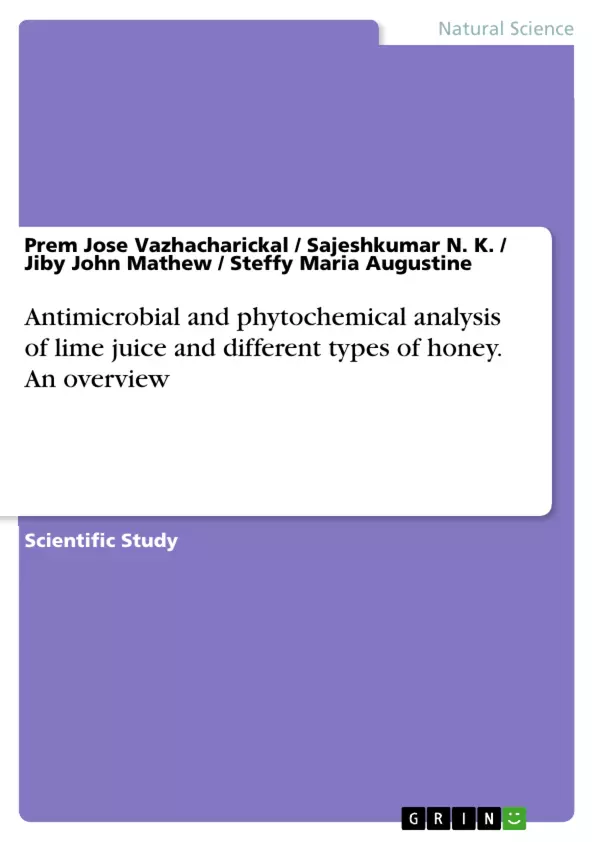Citrus, one of the major genes of Rutaceae family and most economically important fruit tree and widely cultivated throughout the country. The Citrus have high nutritional value and medicinal value. Honey and lemon-honey are traditional remedies in the Middle East and China and for many centuries and have been used in the treatment and prevention of the common cold and various upper respiratory tract infections. Three types of honey were collected; ‘Cheruthen’-produced by bees belongs to the Trigona irridipennis species; Vanthen’- produced by bees belongs to the Apis indica species; ‘Kattutthen’- produced by bees belongs to the Apis dorsata species.
The antibacterial activites of honey samples and lime juice were tested aganist Bacillus, Klebsiella, E.coli, Staphylococcus and Micrococcus. The result showed that the samples have differnt antimicrobial activity. Antimicrobial activity of Cheruthen against Klebsiella species showed a zone of inhibition of 10.1 ± 0.73 mm, when 100 µl of Cheruthen is applied. When 200 µl of Cheruthen is applied the zone of inhibition was 30.1 ± 0.23 mm. Antimicrobial activity of Cheruthen against E.coli showed a zone of inhibition of 10.1 ± 0.13 mm, when 100 µl of cheruthen is applied. When 200 µl of cheruthen is applied the zone of inhibition was 30.2 ± 0.23 mm. Also the phytochemical examination of lime juice and honey samples showed that different types of phytochemical substances are present in both lime juice and different types of honey samples. Further studies are required to reveal the role of each phytochemical and its contribution to the antimicrobial properties of the samples included in this study.
Table of Contents
- Abstract
- 1. Introduction
- 1.1 Objectives
- 1.2 Scope of the study
- 1.3 Taxonomical classification
- 2. Review of literature
- 2.1 Uses and importance
- 3. Hypothesis
- 4. Materials and Methods
- 4.1 Study area
- 4.2 Sample collection
- 4.3 Description of the species
- 4.4 Microorganisms used in the study
- 4.6 Preparation of samples
- 4.7 Preparation of test organisms
- 4.8 Preparation of inoculam and culture media
- 4.9 Antibacterial assay
- 4.10 Phytochemical analysis
- 4.11 Statistical analysis
- 5. Results
- 5.1 Antimicrobial activity of honey and lime juice
- 5.2 Phytochemical analysis
- 6. Discussion
Objectives and Key Themes
This research aims to investigate the antimicrobial and phytochemical properties of lime juice and different types of honey. The study explores the potential of these natural resources as antibacterial agents, analyzing their effectiveness against a range of microorganisms.
- Antimicrobial properties of lime juice and honey
- Phytochemical analysis of lime juice and honey
- Comparative evaluation of different honey types
- Potential application of lime juice and honey as natural antibacterial agents
- Contribution to the understanding of traditional medicinal practices
Chapter Summaries
- Abstract: This chapter provides a concise overview of the research, outlining its objectives, methodology, and key findings.
- 1. Introduction: This section introduces the topic of antimicrobial and phytochemical analysis, highlighting the importance of lime juice and honey as natural resources with potential antibacterial properties. It outlines the study's objectives, scope, and the taxonomical classification of the organisms involved.
- 2. Review of literature: This chapter explores existing research on the uses and importance of lime juice and honey as antibacterial agents, providing a background on their traditional medicinal applications and scientific understanding of their properties.
- 3. Hypothesis: This section presents the research hypotheses, outlining the specific claims or predictions that will be tested through the study.
- 4. Materials and Methods: This chapter details the materials and methods used in the research, including the study area, sample collection, description of the species, microorganisms used, preparation of samples, preparation of test organisms, preparation of inoculam and culture media, antibacterial assay, phytochemical analysis, and statistical analysis.
- 5. Results: This chapter presents the findings of the research, analyzing the antimicrobial activity of honey and lime juice and the phytochemical composition of the samples.
- 6. Discussion: This section interprets the research findings, discussing their significance and implications within the context of existing literature and potential applications.
Keywords
The key focus of this research is on the antimicrobial and phytochemical properties of lime juice and different types of honey. The study investigates the potential of these natural resources as antibacterial agents and explores their efficacy against various microorganisms. The research involves the analysis of the phytochemical composition of these resources and their impact on bacterial growth. Key terms include antimicrobial activity, phytochemical analysis, honey, lime juice, antibacterial agents, and microorganisms.
- Citar trabajo
- Dr. Prem Jose Vazhacharickal (Autor), Sajeshkumar N. K. (Autor), Jiby John Mathew (Autor), Steffy Maria Augustine (Autor), 2016, Antimicrobial and phytochemical analysis of lime juice and different types of honey. An overview, Múnich, GRIN Verlag, https://www.grin.com/document/366729



